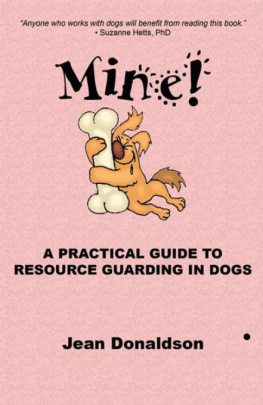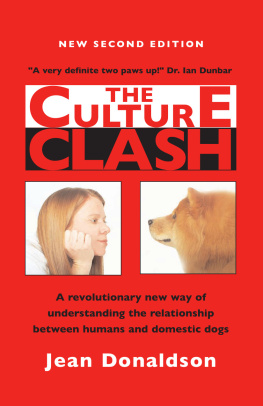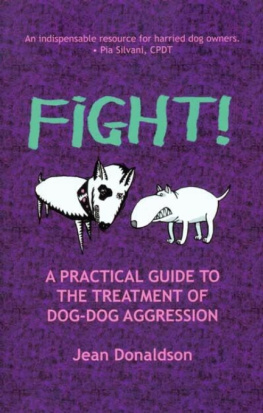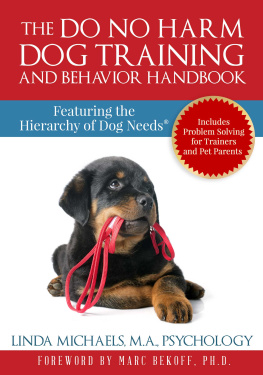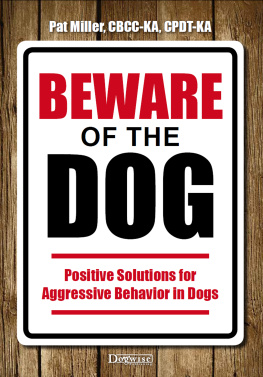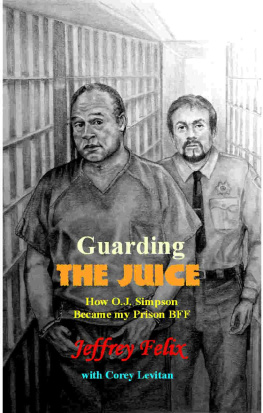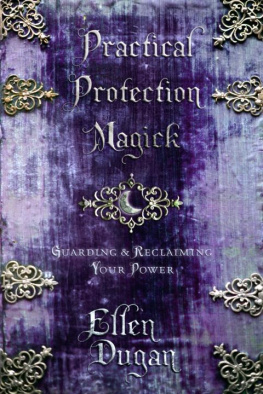Disclaimer
This book is designed for educational purposes only. The services of a competent professional trainer or applied behaviorist should be sought regarding its applicability with respect to your own dog. The training of dogs is not without risk. The author and publisher shall have neither liability nor responsibility to any person or entity with respect to any loss or damage caused or alleged to be caused directly or indirectly by the information contained in this book.
If you do not wish to be bound by the above, you may return this book to the publisher for a full refund.
2002 Jean Donaldson
All rights reserved
Printed in the United States of America
Requests for permission to reprint should be sent to:
The Academy for Dog Trainers
info@academyfordogtrainers.com

ISBN 978-0-9705629-4-4

A Guide to Resource Guarding in Dogs
Contents


A Guide to Resource Guarding in Dogs
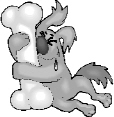
This manual is about dogs who growl, snarl, snap and bite when you try to take things away from them, approach them when they are eating or when they have claimed some other resource, such as their owner or a comfy sleeping location. This is a remarkably common problem but, luckily, can often be successfully resolved and even prevented.
There continues to be rampant animosity towards dogs with aggression problems. My Academy co-instructor, Janis, has pointed out that the attitude, at least here in the US, used to be more relaxed. In a hilarious James Thurber story, a woman sends boxes of chocolates at Christmas to everyone the dog bit that year. One year she sent out 50 boxes. A crotchety dog was more taken in stride and cause for humorous annoyance than cause for litigation, as it would be today. Dogs were animals and animals sometimes bit.
Theres no doubt that a generally more litigious society is part of the picture today. But dogs seem a particularly emotional issue. Comparable injuries caused by, say, opening a can in the kitchen and being bitten by a dog are rarely treated the same way. The latter is more likely to be presented in an emergency room. Every time there is a dog-related fatality, there is pressure on lawmakers to ban breeds of dogs, muzzle all dogs or somehow better protect the public. Yet, the public is at far greater lethal risk from lawnmowers. One is far more likely to be struck by lightning several times or be killed by a power shovel than to ever be killed by a dog. Infant fatalities are a great deal more likely to be associated with 25-gallon plastic barrels than with dog attacks, yet no one is calling for a ban on these. Kids are also astronomically more likely to be injured or killed by a parent or guardian. Our expectations of dogs are high.
Our expectations of dogs are very high, actually. The standard we have set for them is one we would consider absurd for any other species of animal, including ourselves. We want no aggressive behavior directed at humans, of even the most ritualized sort, at any time, over the entire course of the dogs life. This is exactly like you going a lifetime without ever once losing your temper, swearing at another driver in traffic, being rude to someone in a line-up, writing a hot letter to the editor, defending yourself from what you perceive to be a threat, calling a lawyer or saying something mean to your spouse that you later regret. All species-normal, even highly ritualized aggression forbidden.
As if this werent enough, we also want dogs to suddenly be very aggressive if a crime is being perpetrated against us. We want the dog to be able to tell the good guys from the bad guys and guard our own coveted resources! We even breed dogs with this in mind, flirting with the deliberate selection of traits such as wary of strangers, one man or one family dog or other euphemisms that suggest we dont want dogs to be entirely gregarious and easy to socialize. It doesnt occur to us the extreme unlikelihood of achieving through selective breeding a dog who is more likely to guard a stereo than a meaty bone.
I am not suggesting we dont take dog aggression seriously and do everything we can to eliminate it. What I am suggesting is that a good start for this effort would be acknowledging the bar we are setting. It is extremely predictable that dogs, like all animals, will behave aggressively when they are afraid or feel threatened and in order to defend resources. If we would like to have this never, or almost never, happen, we will have to insert multiple lines of defense, starting with facing up to the biological legacy we are up against.
When I get angry or feel wronged, there is a big difference between suing you or being rude to you and pulling out a firearm and shooting at you. Although all are aggressive acts, one kind is ritualized and one is not. Our laws reflect our recognition that some kinds of conflict resolution and aggression are okay and some are not. The essence of this difference is the degree of damage inflicted. Sports which are inherently about winning in a conflict situation - make this distinction as well. The ubiquity of rules in sport implies that we agree on a need for rules and conventions governing how we can engage in them.

Similarly, there is a big difference in ritualized and non-ritualized conflict resolution behavior in dogs. Hard stares, growling, snarling, snapping and biting without maiming force are the legal conflict resolution behaviors in dog society. They are ways for dogs to settle conflicts to say back off! if you will - without the high price to all participants of flat-out uninhibited aggression. Dogs are equipped with maim-force jaws, capable of crushing bone and tearing flesh. They carry these heavy weapons with them at all times, yet have managed to not self-annihilate as a species, in spite of lots of arguing about bones, mates and carcasses. The reason is a long history of selection for well-developed ritualization.
The following are components of ritualized aggression in dogs. They communicate the internal state and willingness to guard to the approaching threat, and advertise agonistic capability (See these teeth? Hear this big growl? Id be a formidable opponent in a fight). Accelerated consumption is specific to warning competitors away from resources; the rest are used in all types of back off situations.
1) Freezing up
Also called hard-eyeing, a glassy-eyed stare accompanies a cessation of activity. If the dog was chewing, he stops chewing. If the dog was eating, he stops eating. The stare is oblique, rarely directly at the approaching threat. Owners may report the hard, detached, spaced out looking expression, mistaking it for some sort of seizure.
2) Accelerated consumption
In contrast to a cessation of consumption, acceleration is just that: if the dog was eating, he starts eating faster, almost punching at the food. If the dog was chewing, he starts chewing faster and more intensely.
Next page
